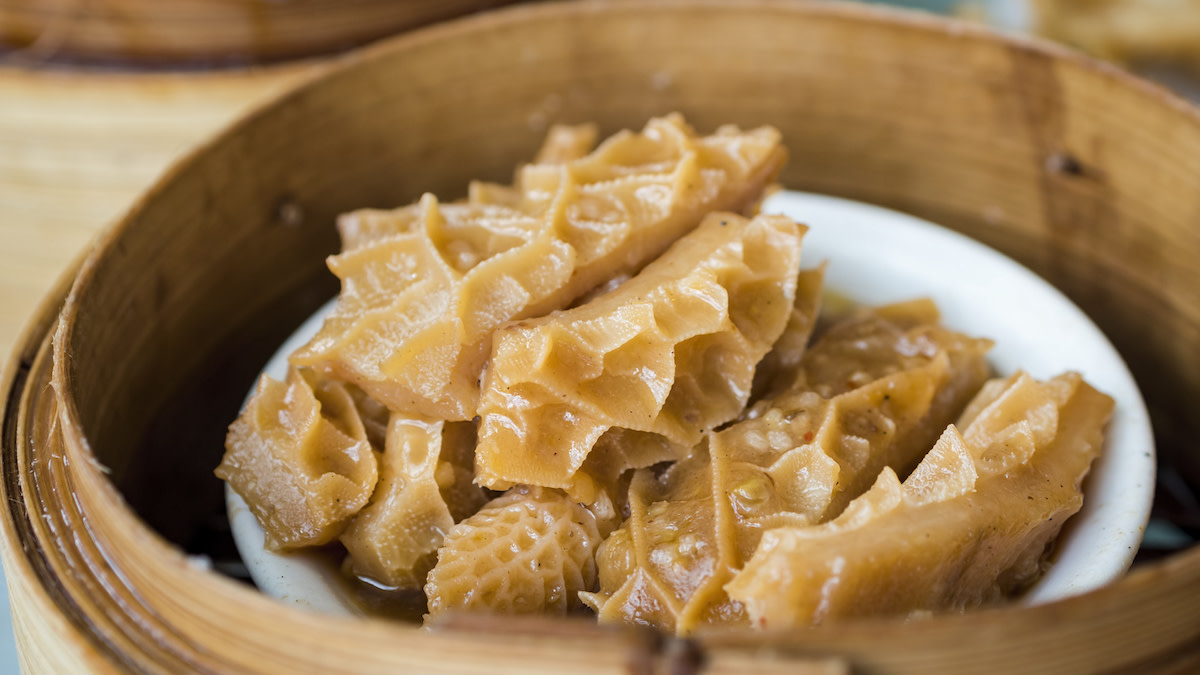
The English language does little service to tripe. The dictionary tells us that the word means guts or entrails used as food. Alternatively: nonsense, gibberish, worthless, rubbish. Offal does no better. One must spell the word rather than say it to get their point across. How to convince the wary eater to eat awful rubbish? Deep fry it, of course.
What is Tripe?
Tripe refers to the edible parts of the four stomachs of a ruminant animal such as a sheep, deer, goat, or cow. The four stomachs of these animals work as fermentation chambers, turning indigestible cellulose from plant matter into proteins, vitamins, and minerals to be digested in the intestines. The rumen, known as blanket tripe, is the first and largest of the stomachs. It acts as a large fermentation vat, storing and slightly fermenting the mass amounts of grass and other plant matter ruminants eat in a day. Microbes work in the rumen to break down the cellulose into volatile fatty acids, the first energy the animal receives from their food.
Food then passes into the reticulum, known as honeycomb tripe, where the heavy fermentation begins. During this secondary breakdown in the reticulum, chunks of soft matter are regurgitated back into the mouth as cud, which the animal chews or ruminates on. Once the cud is swallowed, it passes to the third stomach, the omasum. This omasum is called book tripe, and the page-like folds of this stomach absorb all the water from the food.
The fourth stomach is the abomasum, similar to the stomachs of monogastric animals such as pigs or humans. This is where glands release hydrochloric acid, digestive enzymes, and other gastric juices to break down the remaining plant matter before it enters the small intestine. The abomasum is not commonly used as tripe.
Harvesting and Cleaning Tripe
When gutting an animal, the maze of intestines, stomachs, spleen, and liver can be overwhelming at first glance. But nature makes no mistakes. Once untangled, the pile of guts maps a clear line from stomach to stomach, each one shaped differently than the last. The first three stomachs, the rumen, reticulum, and omasum, are the ones you want to save for tripe.
Once the three stomachs are located, cut them open and empty the contents. Most of it will be grass in varying states of fermentation. A good rinse with a hose should get the largest chunks out. For easier cleaning, cut eat stomach into smaller pieces, about 10 inches square.
To prepare for cooking, begin by trimming fat and anything that does not look like tripe. The linings of the stomachs are coated in a dark layer of residue that needs to be scraped off. This can be done by dipping pieces of tripe into a pot of boiling water and using a sharp knife to scrape the lining once it has loosened. The tripe can also be simmered for about 10 minutes and then rubbed with a mixture of salt and vinegar to remove any excess residue. Continue scraping and rubbing with salt until all residue is removed. This process is tedious and time-consuming, but it is essential to making the tripe safe to eat.
Cooking Tripe
When the tripe is completely clean of impurities, it must be boiled with salt for about 10 minutes and then rinsed with cold water. Tripe at the grocery store is bright white because it is soaked in a chlorine or bleach solution. Bleached tripe must also be parboiled before cooking to remove any remaining chemicals. Once the tripe is clean and boiled, it is ready to be cooked.
Tripe is the main ingredient of some of the most iconic and well-loved dishes worldwide. Mexico has menudo, a spicy tripe soup with hominy and tomatoes. The Philippines has kare-kare, an oxtail, tripe, and peanut stew. The Italians have trippa alla Romana with tomato sauce and parmesan, while the French put tripe in andouille sausage. The English serve tripe salad with mint and fresh peas. And, of course, there’s always my favorite, fried tripe. Crispy on the outside, tender, and fatty on the inside dipped in a caper and red onion aioli. Ruminate on that.






